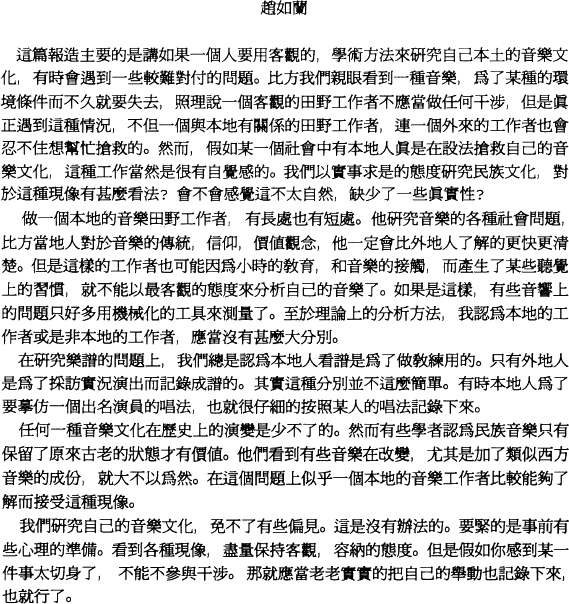Article contents
Return of the Native Ethnomusicologist
Published online by Cambridge University Press: 07 March 2019
Extract
In the summer of 1986 I made a trip to Lotus Mountain of Gansu Province in China. The occasion was the Festival of Flower Song Singing, which takes place once a year there. This was the first time that outside visitors were allowed to come to this region and witness the activities. Our party consisted of half a dozen Chinese scholars, two visitors from Japan, an American graduate student, and myself, whom the Chinese authorities regarded as a visitor from abroad.

- Type
- Articles
- Information
- Copyright
- Copyright © 1992 by the International Council for Traditional Music
Footnotes
Read at the 31st ICTM World Conference in Hong Kong, July 1991.
References
Notes
1. For more details about this trip, see Pian, R.C., “The Flower Song Festival at Lotus Mountain: A Study in Performance Context.” In New Perspectives On Music: Essays in Honor of Eileen Southern. Ed. by Josephine Wright, Harmonie Park Press, Michigan, 1992, pp. 341–352.Google Scholar
2. See for example Alan Merriam, Anthropology of Music, Northwestern University Press, 1964, p. 25.Google Scholar
3. Op. cit., p. 33.Google Scholar
4. Alan Lomax, Cantometrics, University of California, Berkeley, 1976.Google Scholar
5. Pian, R.C., “Text Setting with the Shipyi Animated Aria.” In Words and Music: The Scholar's View (A Medley of Problems & Solutions, Compiled in Honor of A. Tillman Merritt, by Sundry Hands) Ed. L. Berman, Harvard University, 1972, p. 237–270.Google Scholar
6. See for example, discussion by Bruno Nettl, The Study of Ethnomusicology, University of Illinois Press, 1983, p. 72.Google Scholar
7. For example, the Ming dynasty work, Duh Cheu Shiu Jy 度曲須矢ロ [Rules for Realizing a Dramatic Song] by Sheen Choong-swei 沈寵緩.Google Scholar
8. For example, the compilation, Jeou Gong Dah Cherng Nan-beei Tsyr Gong Puu [Musical scores of the Northern and Southern Poetic Songs Arranged in the Order of the Nine Modes] in 82 chapters, comp. Jou Shyang-yuh 九宮大成南:!匕言司宮譜 by imperial order, 1743.Google Scholar
9. A detailed description of this process as practiced in the Cantonese Opera is given by Bell Yung in his book, Cantonese Opera: Performance as Creative Process, Cambridge Studies in Ethnomusicology, 1989.Google Scholar
10. A good example is the collection, Jing Jiuh Chanq Chiang 京劇卩昌月空 [Arias from the Peking Opera] in 4 volumes, with transcriptions based upon recordings of various leading performers of the Peking Opera, Peking. (Published in 1959-63. But the recordings can be much older.)Google Scholar
11. Op. cit., Chap. XV, “Music and Cultural Dynamics.”Google Scholar
12. Bruno Nettl, The Western Impact on World Music, Schirmer, N.Y., 1985.Google Scholar
13. Fang Kun, 方楚" “A Discussion on Chinese National Musical Traditions” (tran. by Keith Pratt) Asian Music XII-2, 1981: 1-9.Google Scholar
14. Shin Shy Ge Jyi 新詩歌集 [A Book of Songs with New Lyrics] The Commercial Press, Shanghai, 1928. Incorporated in The Complete Musical Works of Yuen Ren Chao, 趙元任 comp. by R.C. Pian, The Music Press, Shanghai, 1987.Google Scholar
15. Op. cit., Preface.Google Scholar
- 2
- Cited by




